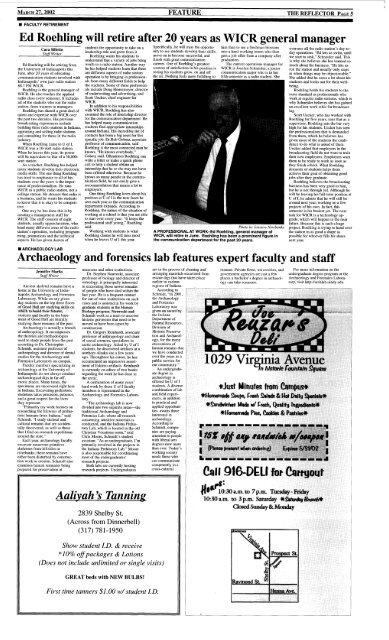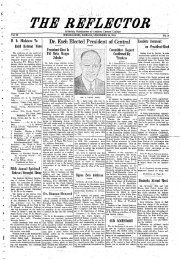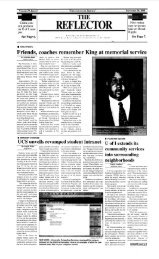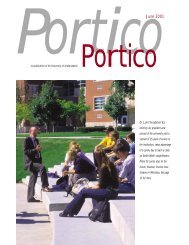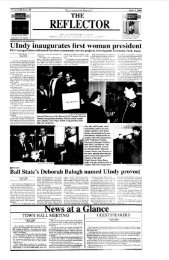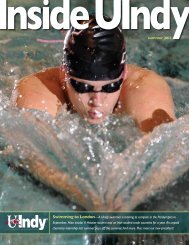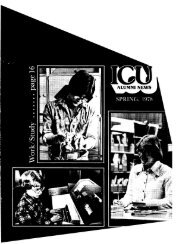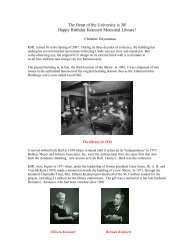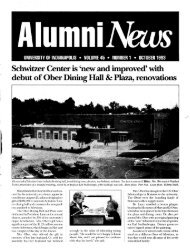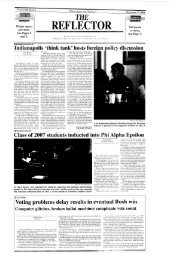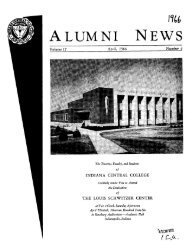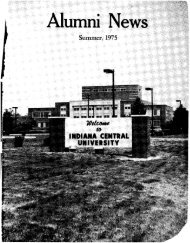the reflector - Frederick D. Hill Archives - University of Indianapolis
the reflector - Frederick D. Hill Archives - University of Indianapolis
the reflector - Frederick D. Hill Archives - University of Indianapolis
You also want an ePaper? Increase the reach of your titles
YUMPU automatically turns print PDFs into web optimized ePapers that Google loves.
MARCH 27,2002 FEATURE THE REFLECTOR PAGE 5<br />
FACULTY RETIREMENT<br />
Ed Roehling will retire after 20 years as WICR general manager<br />
Cara Silletto<br />
Stuff Writer<br />
Ed Roehling will be retiring from<br />
<strong>the</strong> <strong>University</strong> <strong>of</strong> <strong>Indianapolis</strong> this<br />
June, after 20 years <strong>of</strong> educating<br />
communication students involved with<br />
<strong>Indianapolis</strong>’ own jazz radio station<br />
88.7 FM WICR.<br />
Roehling is <strong>the</strong> general manager <strong>of</strong><br />
WICR. He also teaches <strong>the</strong> applied<br />
radio class every semester. It includes<br />
all <strong>of</strong> <strong>the</strong> students who run <strong>the</strong> radio<br />
station, from trainees to managers.<br />
Roehling has shared a great deal <strong>of</strong><br />
talent and expertise with WICR over<br />
<strong>the</strong> past two decades. His previous<br />
broadcasting experiences include<br />
building three radio stations in Indiana,<br />
appraising and selling radio stations<br />
and consulting for those in <strong>the</strong> radio<br />
industry.<br />
When Roehling came to U <strong>of</strong> I,<br />
WICR was a 10-watt radio station.<br />
When he leaves this year, its power<br />
will be equivalent to that <strong>of</strong> a 30,000-<br />
watt station.<br />
As a teacher, Roehling has helped<br />
many students develop <strong>the</strong>ir electronic<br />
media skills. The one thing Roehling<br />
has tried to emphasize to all <strong>of</strong> his<br />
students over <strong>the</strong> years is <strong>the</strong> impor-<br />
tance <strong>of</strong> pr<strong>of</strong>essionalism. He runs<br />
WICR as a public radio station, not a<br />
college station. He stresses that radio is<br />
a business, and he wants his students<br />
to know that it is okay to be competi-<br />
tive.<br />
One way he has done this is by<br />
creating a management staff for<br />
WICR. The staff consists <strong>of</strong> eight<br />
students, usually upperclassmen, who<br />
head many different areas <strong>of</strong> <strong>the</strong> radio<br />
station’s operation, including program-<br />
ming, promotions and <strong>the</strong> technical<br />
aspects. He has given dozens <strong>of</strong><br />
ARCHAEOLOGY LAB<br />
Archaeology<br />
Jennifer Marks<br />
Stuff Writer<br />
Ancient skeletal remains have a<br />
home at <strong>the</strong> <strong>University</strong> <strong>of</strong> <strong>Indianapolis</strong><br />
Archaeology and Forensics<br />
Laboratory. While on any given<br />
day students on <strong>the</strong> top three floors<br />
<strong>of</strong> Good Hall are studying skills on<br />
WMkh to’,bui€d <strong>the</strong>$ ~U~UITYS, a<br />
students and faculty in <strong>the</strong> basement<br />
<strong>of</strong> Good Hall are literally<br />
studying <strong>the</strong>se remains <strong>of</strong> <strong>the</strong> past.<br />
Archaeology is actually a branch<br />
<strong>of</strong> anthropology. It encompasses<br />
<strong>the</strong> <strong>the</strong>ories and methodologies<br />
used to study people from <strong>the</strong> past<br />
according to Dr. Christopher<br />
Schmidt, assistant pr<strong>of</strong>essor <strong>of</strong><br />
anthropology and director <strong>of</strong> dental<br />
studies for <strong>the</strong> Archaeology and<br />
Forensics Laboratory on campus.<br />
Faculty members specializing in<br />
archaeology at <strong>the</strong> <strong>University</strong> <strong>of</strong><br />
<strong>Indianapolis</strong> do not always conduct<br />
archaeological digs in far-<strong>of</strong>f,<br />
exotic places. Many times, <strong>the</strong><br />
specimens are uncovered right here<br />
in Indiana. Excavating prehistoric<br />
skeletons takes precision, patience,<br />
and a great respect for <strong>the</strong> lives<br />
<strong>the</strong>y represent.<br />
“Primarily my work focuses on<br />
researching <strong>the</strong> lifeways <strong>of</strong> prehistoric<br />
humans from Indiana,” said<br />
Schmidt. “I study skeletal and<br />
cultural remains that are accidentally<br />
discovered, as well as those<br />
that I find on research expeditions<br />
around <strong>the</strong> state.”<br />
Each year, archaeology faculty<br />
excavate numerous primitive<br />
skeletons from hillsides or<br />
riverbanks; <strong>the</strong>se remains have<br />
ei<strong>the</strong>r been disturbed by construction<br />
work or erosion. Schmidt also<br />
examines human remnants being<br />
’<br />
students <strong>the</strong> opportunity to take on a<br />
leadership role and grow from it.<br />
Roehling wants his students to<br />
understand that a variety <strong>of</strong> jobs bring<br />
worth to a radio station. Ano<strong>the</strong>r way<br />
he has helped students learn that <strong>the</strong>re<br />
are different aspects <strong>of</strong> radio station<br />
operation is by bringing in pr<strong>of</strong>essionals<br />
from many different fields to help<br />
<strong>the</strong> students. Some <strong>of</strong> <strong>the</strong>se pr<strong>of</strong>essionals<br />
include Doug Housemeyer, director<br />
<strong>of</strong> underwriting and advertising, and<br />
Scott Uecker, chief engineer for<br />
WICR.<br />
In addition to his responsibilities<br />
with WICR, Roehling has also<br />
assumed <strong>the</strong> role <strong>of</strong> internship director<br />
for <strong>the</strong> communication department. He<br />
has helped many communication<br />
students find appropriate internshps<br />
around Indiana. His incredible list <strong>of</strong><br />
contacts has been a big asset for this<br />
specific job. Dr.Rob Gobetz, associate<br />
pr<strong>of</strong>essor <strong>of</strong> communication, said<br />
Roehling is <strong>the</strong> most connected man he<br />
knows. “He knows everybody,”<br />
Gobetz said. Oftentimes Roehling can<br />
write a letter or make a quick phone<br />
call to help a student obtain an<br />
internship that he or she may not have<br />
been <strong>of</strong>fered o<strong>the</strong>rwise. Because he<br />
knows so many people in <strong>the</strong> communication<br />
field, he can easily give a<br />
recommendation that means a lot to<br />
employers.<br />
One thing Roehling loves about his<br />
position at U <strong>of</strong> I is <strong>the</strong> new faces he<br />
sees each year as <strong>the</strong> communication<br />
department expands. According to<br />
Roehling, <strong>the</strong> nature <strong>of</strong> <strong>the</strong> situation <strong>of</strong><br />
working at a school is that you are able<br />
to start over every year. “It keeps <strong>the</strong><br />
pr<strong>of</strong>essional staff young,” Roehling<br />
said.<br />
Working with students is what<br />
Roehling claims he will miss most<br />
when he leaves U <strong>of</strong> I this year.<br />
Specifically, he will miss <strong>the</strong> opportu-<br />
nity to see students develop <strong>the</strong>ir skills,<br />
move on to become successful, and<br />
finish with great communication<br />
careers. One <strong>of</strong> Roehling’s greatest<br />
sources <strong>of</strong> satisfaction in his position is<br />
seeing his students grow, on and <strong>of</strong>f<br />
<strong>the</strong> air. Nothing feels more fulfilling to<br />
him than to see a freshman blossom<br />
into a hard-working intern who <strong>the</strong>n<br />
gets a job <strong>of</strong>fer from a company after<br />
graduation.<br />
The current operations manager for<br />
WICR is Jocelyn Schneider, a junior<br />
communication major who is in her<br />
fifth semester as a radio student. She<br />
Photo by January Newbunks<br />
A PROFESSIONAL AT WORK-Ed Roehling, general manager <strong>of</strong><br />
WICR, will retire in June. Roehling has been a prominent figure in<br />
<strong>the</strong> communication department for <strong>the</strong> past 20 years.<br />
oversees a11 <strong>the</strong> radio station’s day-today<br />
operations. “Ed lets us swim, until<br />
we start to sink,” Schneider said. This<br />
is why she believes she has learned so<br />
much about <strong>the</strong> business. “He lets us<br />
run <strong>the</strong> station and usually only steps<br />
in when things may be objectionable.”<br />
She added that he cares a lot about his<br />
students and looks out for <strong>the</strong>ir wellbeing.<br />
Roehling holds his students to <strong>the</strong><br />
same standard as pr<strong>of</strong>essionals who<br />
work at regular radio stations, which is<br />
why Schneider believes she has gained<br />
an excellent work ethic for broadcasting.<br />
Scott Uecker, who has worked with<br />
Roehling for five years, says that as a<br />
supervisor, Roehling sets <strong>the</strong> bar very<br />
high for his students. Uecker has seen<br />
<strong>the</strong> pr<strong>of</strong>essionalism that is demanded<br />
from <strong>the</strong>m, which he believes has<br />
given most <strong>of</strong> <strong>the</strong> students <strong>the</strong> confi-<br />
dence to do what is asked <strong>of</strong> <strong>the</strong>m.<br />
Uecker added that employers in <strong>the</strong><br />
broadcasting field do not want to train<br />
<strong>the</strong>ir new employees. Employers want<br />
<strong>the</strong>m to be ready to work as soon as<br />
<strong>the</strong>y finish school. What Roehling<br />
demands <strong>of</strong> students helps <strong>the</strong>m<br />
achieve <strong>the</strong>ir goal <strong>of</strong> obtaining good<br />
jobs after <strong>the</strong>y graduate.<br />
Roehling believes <strong>the</strong> broadcasting<br />
business has been very good to him,<br />
but he is not through yet. Although he<br />
will be leaving his full-time position at<br />
U <strong>of</strong> I, he admits that he will still be<br />
around next year, working on a few<br />
projects <strong>of</strong> his own. In fact, this<br />
semester is his busiest yet. The next<br />
task for WICR is a technology up-<br />
grade, which will happen in <strong>the</strong> near<br />
future. Because this is such a huge<br />
project, Roehling is trying to hand over<br />
<strong>the</strong> station in as good a shape as<br />
possible for whoever fills his shoes<br />
next year.<br />
and forensics lab features expert faculty and staff<br />
museums and o<strong>the</strong>r institutions.<br />
Dr. Stephen Nawrocki, associate<br />
Dr<strong>of</strong>essor <strong>of</strong> biolonv and director <strong>of</strong><br />
U d<br />
osteology, is principally interested<br />
in excavating those newer remains<br />
<strong>of</strong> people who have died within <strong>the</strong><br />
last year. He is a frequent contact<br />
for out-<strong>of</strong>-state institutions on such<br />
cases and is assisted in his work by<br />
graduate students in <strong>the</strong> Human<br />
Biology program. Nawra and<br />
Schmidt work as a team to uncover<br />
historic gravesites that need to be<br />
moved or have been upset by<br />
construction.<br />
Dr. Gregory Reinhardt, associate<br />
pr<strong>of</strong>essor <strong>of</strong> anthropology and chair<br />
<strong>of</strong> social sciences, specializes in<br />
arctic archaeology. Aided by U <strong>of</strong> I<br />
students, he discovered artifacts at a<br />
nor<strong>the</strong>rn Alaska site a few years<br />
ago. Throughout his career, he has<br />
accumulated an impressive assortment<br />
<strong>of</strong> Eskimo artifacts. Reinhardt<br />
is currently co-editor <strong>of</strong> two books<br />
regarding <strong>the</strong> work he has done in<br />
<strong>the</strong> arctic.<br />
A culmination <strong>of</strong> many years’<br />
hard work by <strong>the</strong>se U <strong>of</strong> I faculty<br />
members is represented in <strong>the</strong><br />
Archaeology and Forensics Laboratory.<br />
“The archaeology lab is now<br />
divided into two separate areas-<strong>the</strong><br />
traditional Archaeology and<br />
Forensics Lab, where all research<br />
concerning sensitive materials is<br />
conducted, and <strong>the</strong> Indiana Prehistory<br />
Lab, which is located in <strong>the</strong> old<br />
Christian Vocations room,” said<br />
Chris Moore, Schmidt’s student<br />
assistant. “As an undergraduate, I’m<br />
primarily involved in <strong>the</strong> projects in<br />
<strong>the</strong> Indiana Prehistory Lab.” Moore<br />
is also responsible for coordinating<br />
most <strong>of</strong> <strong>the</strong> undergraduates’<br />
research projects.<br />
Both labs are currently hosting<br />
are in <strong>the</strong> process <strong>of</strong> cleaning and<br />
arranging materials excavated from<br />
rescue digs that have taken place<br />
earlier inharious<br />
regions <strong>of</strong> Indiana.<br />
According to<br />
Schmidt, “In 2001,<br />
<strong>the</strong> Archaeology<br />
and Forensics<br />
Laboratory was<br />
given an award by<br />
<strong>the</strong> Indiana<br />
Department <strong>of</strong><br />
Natural Resources,<br />
Division <strong>of</strong><br />
Historic Preservation<br />
and Archaeology,<br />
for <strong>the</strong> many<br />
excavations <strong>of</strong><br />
human remains that<br />
we have conducted<br />
over <strong>the</strong> years as a<br />
public service for<br />
our community.”<br />
An undergradu-<br />
ate degree in<br />
archaeology is<br />
<strong>of</strong>fered for U <strong>of</strong> I<br />
students. A diverse<br />
combination <strong>of</strong> lab<br />
and field experiences,<br />
in addition<br />
to practical and<br />
applied opportunities,<br />
awaits those<br />
interested in<br />
archaeology.<br />
According to<br />
Schmidt, companies<br />
are paying<br />
attention to people<br />
with liberal arts<br />
degrees now more<br />
than ever. Today’s<br />
working society<br />
needs those who<br />
can communicate<br />
competently in a<br />
prepared for preservation at research projects. Undergraduates cross-cultural<br />
Aaliyah k Tanning<br />
2839 Shelby St.<br />
(Across from Dinnerbell)<br />
(317) 781-1950<br />
Show student I.D. & receive<br />
*lo% <strong>of</strong>fpackages & Lotions<br />
(Does not include unlimited or single visits)<br />
GREAT beds with NEW BULBS!<br />
First time tanners $1.00 whtudent I.D.<br />
manner. Private firms, universities, and<br />
government agencies are just a few<br />
Dlaces a bachelor’s degree in archaeol-<br />
For more information on <strong>the</strong><br />
undergraduate degree program or <strong>the</strong><br />
Archaeologv and Forensics Labora-<br />
Y<br />
ogy can take someone. tory, visit i;ftp://archlab.uindy.edu.<br />
Call 916-DELl fOt Carryout,<br />
~


